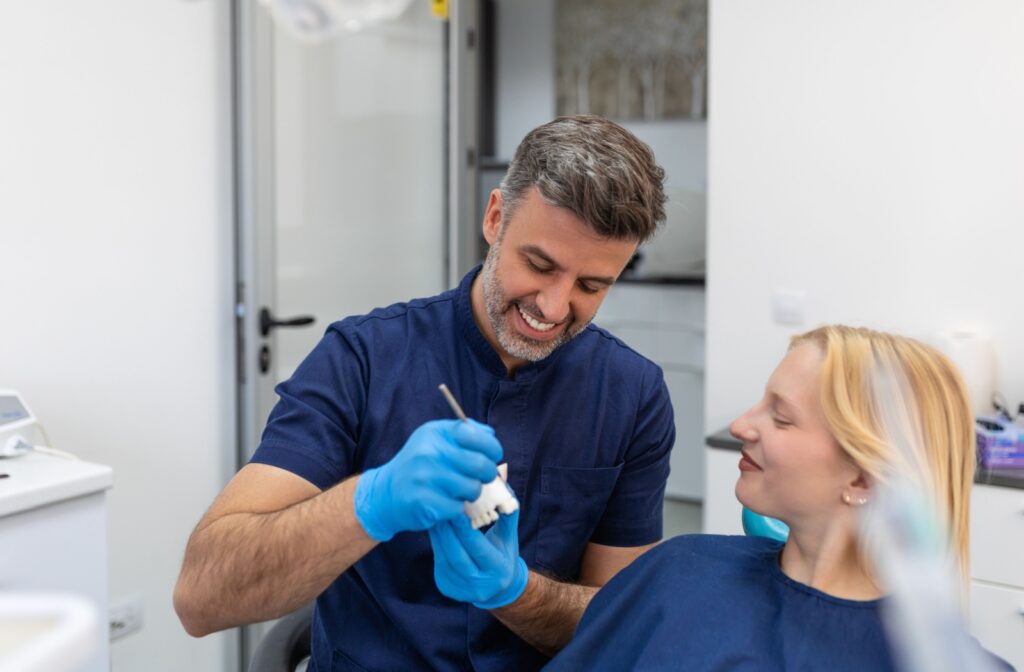Dental bridges, a common choice for filling the gaps left by missing teeth, play a role in not only restoring the functional aspect of your bite but also in enhancing the aesthetic appeal of your smile.
These prosthetic devices bridge the space where teeth are absent, using the remaining teeth as anchors, thus providing a more seamless and natural appearance.
However, despite their durability and the significant improvements they bring to oral health, dental bridges, like any dental appliance, have a lifespan.
What Is a Dental Bridge?
A dental bridge is used to replace missing teeth. It consists of 1 or 2 false teeth (pontics) cemented to the teeth adjacent to the gap, supported by crowns on each end.
These are not removable. For more than 2 missing teeth, implant restoration is generally needed. In some cases, a bridge can also be secured by dental implants.
Why Might a Dental Bridge Need to Be Replaced?
Over time, wear and tear can compromise the structure and functionality of the bridge. Damage from accidents or biting hard objects can also require replacement.
Additionally, changes in the fit can cause discomfort, and aesthetic concerns may emerge as the bridge ages.
Signs That Your Dental Bridge Needs Replacement
- Persistent pain or discomfort around the bridge area can indicate issues.
- Instability or movement of the bridge when eating or speaking suggests it might be loose.
- Visible damage, such as cracks or chips, also means it is time for a new bridge.
The Lifespan of a Dental Bridge
On average, a dental bridge lasts between 5 to 15 years, depending on a few factors. Ways to expand the lifespan of your bridges include:
- Proper oral hygiene
- Regular dental checkups
- Avoiding harmful habits like teeth-grinding
However, even with the best care, bridges may eventually need to be replaced.
The Replacement Process & What to Expect
- First, your dentist will evaluate the current bridge and the supporting teeth or implants.
- They will then remove the old bridge and prepare the area for a new one.
- Impressions of your teeth will be taken to create a custom-fit replacement.
- Lastly, the new bridge will be fitted, adjusted, and cemented into place.
Choosing the Right Replacement Option
Choosing the appropriate replacement for your dental bridge requires careful consideration of the bridge type, the state of your abutment teeth or implants, and your general oral health.
Your dentist will assist you in navigating through the available options, ensuring you select the most suitable solution that aligns with your needs and preferences.
Cost Considerations for Replacing a Dental Bridge
The cost of replacing a dental bridge can vary widely based on the type of bridge, the materials used, and the complexity of the procedure.
Dental insurance may cover a portion of the cost, but make sure to discuss your coverage with your provider. Some dental offices offer payment plans to make the process more affordable.
Types of Dental Bridges
Traditional Bridges
Traditional bridges involve creating crowns for the teeth or implants on either side of the missing tooth, with a pontic in between.
These are the most common type and offer strong support but may require significant preparation of the adjacent teeth.
Cantilever Bridges
Cantilever bridges are used when there are adjacent teeth on only one side of the missing tooth. These are less common today and are generally recommended only in specific situations due to the uneven distribution of force.
Maryland Bridges
Maryland bridges, also known as resin-bonded bridges, use a metal or porcelain framework bonded to the back of the adjacent teeth. These require minimal preparation but are less durable than other types.
Implant-Supported Bridges
Implant-supported bridges are anchored by dental implants rather than natural teeth. These provide excellent stability and do not affect adjacent teeth, making them a preferred option for many.
Caring for Your New Dental Bridge
Proper care and maintenance of your new dental bridge are important for its longevity.
- Brush and floss daily, paying special attention to the area around the bridge.
- Use a fluoride mouthwash.
- Avoid hard or sticky foods that could damage the bridge.
- Regular dental checkups will allow your dentist to monitor the condition of your bridge and address any issues.
Learn More at Kensington Dental Care
Replacing a dental bridge can be an important step in maintaining a healthy, functional smile. By addressing the need for replacement promptly and choosing the right solution, you can continue to enjoy the benefits of a complete, beautiful set of teeth.If you suspect your dental bridge needs replacement, do not hesitate to book an appointment with Kensington Dental Care. A healthy, bright smile is well within your reach.










